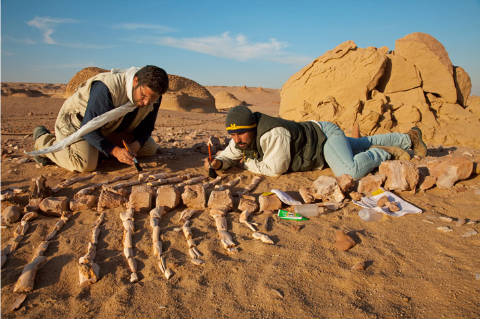Evolution doesn’t have to operate at a snail’s pace, even for snails. In experiments designed to simulate the evolutionary transition that produced slugs, researchers exposed baby snails to the metal platinum, causing the animals to develop without external shells. The research illustrates how a big leap on the evolutionary path of animal body plans might have occurred. It also reopens a can of worms concerning the development and evolution of an entire class of shelled creatures.
![]() Scientists reared Marisa snails, best known for cleaning up algae and other debris in home aquariums, in petri dishes containing varying concentrations of platinum. At certain exposures, all of the roughly 80 percent of snails that survived were shell-less, Heinz Köhler of the University of Tübingen in Germany and his colleagues report in the September-October Evolution & Development. The researchers posit that the platinum is causing effects similar to the genetic mutation that turned off shell production in some snails, paving the way for their slug descendants.
Scientists reared Marisa snails, best known for cleaning up algae and other debris in home aquariums, in petri dishes containing varying concentrations of platinum. At certain exposures, all of the roughly 80 percent of snails that survived were shell-less, Heinz Köhler of the University of Tübingen in Germany and his colleagues report in the September-October Evolution & Development. The researchers posit that the platinum is causing effects similar to the genetic mutation that turned off shell production in some snails, paving the way for their slug descendants.
“This shows that you can get really dramatic changes that could be similar to the genetic mutations that drive evolution, without worrying about doing everything in small incremental steps,†says comparative physiologist Roger Croll of Dalhousie University in Halifax, Nova Scotia. “This is a very concrete demonstration, a very clear demonstration of a large-scale change in body plan. All of a sudden you get shell-less animals.â€
Evidence suggests that transitions from snails to slugs — or rather, from having a concrete outer shell to a greatly reduced internal one — have happened numerous times in evolution. Such losses or gains occurred repeatedly within the Mollusca, an enormous group that includes clams, oysters, squid, octopuses and of course the gastropods —snails and slugs. The internal flat bone of cuttlefish and squid, for example, is thought to be a pared-down version of an ancestral outer molluscan shell. And the shell game continued within the gastropods. Within the marine gastropods known as sea butterflies and sea hares, for example, there are both shelled and shell-less species.
Though the new study shows that shell loss in gastropods can happen in one fell swoop, it also suggests that another evolutionary transition might have required several steps to complete. Torsion is an anatomical hallmark of the gastropods that makes them look like their bottom halves were rotated 180 degrees relative to their top halves, putting their anuses over their heads. The term torsion also refers to the hypothetical evolutionary process that purportedly led to this awkward anatomy, says evolutionary biologist Louise Page of the University of Victoria in British Columbia.
The new research suggests that torsion might not have occurred in one grand swivel. In many gastropods the anus, gills and mantle cavity are rotated 180 degrees. But in some there is partial rotation. And in the snails that Köhler and his colleagues exposed to platinum there was partial rotation as well: The anus swiveled but the gills and mantle were left in their original positions. This suggests that the gastropod body plan could have arisen through physiological means other than torsion, such as asymmetrical growth, where one half of the body atrophied and the other blossomed.
“This paper helps people to think about the fact that these anatomical positions are not necessarily coupled together,†says Page. “It really demonstrates that development is modular, that you can have quite drastic modifications of the development of one component of the body plan but not others.â€
See Also:
- Deep-Sea Snail Shell Could Inspire Better Body Armor
- Oversexed Female Snails Make Males Chase Each Other
- 200 New Species of Frogs, Spiders, Mammals and More Discovered
- 10 Strange Species Discovered Last Year
Image: Goethe University





